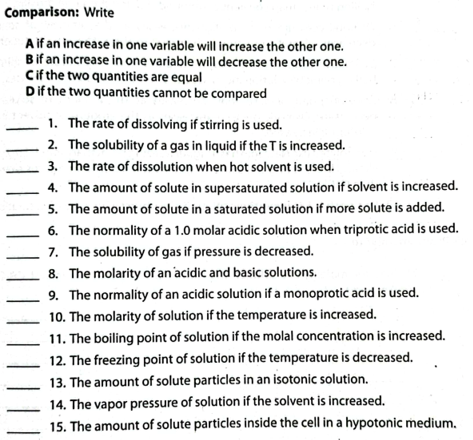Aif an increase in one variable will increase the other one. Bif an increase in one variable will decrease the other one. Cif the two quantities are equal Dif the two quantities cannot be compared 1. The rate of dissolving if stirring is used. 2. The solubility of a gas in liquid if the T is increased. 3. The rate of dissolution when hot solvent is used. ||
Aif an increase in one variable will increase the other one. Bif an increase in one variable will decrease the other one. Cif the two quantities are equal Dif the two quantities cannot be compared 1. The rate of dissolving if stirring is used. 2. The solubility of a gas in liquid if the T is increased. 3. The rate of dissolution when hot solvent is used. ||
Chapter80: Crystallization: Purification Of Solids
Section: Chapter Questions
Problem 1P
Related questions
Question
100%

Transcribed Image Text:Comparison: Write
A if an increase in one variable will increase the other one.
Bif an increase in one variable will decrease the other one.
Cif the two quantities are equal
Dif the two quantities cannot be compared
1. The rate of dissolving if stirring is used.
2. The solubility of a gas in liquid if the T is increased.
3. The rate of dissolution when hot solvent is used.
4. The amount of solute in supersaturated solution if solvent is increased.
5. The amount of solute in a saturated solution if more solute is added.
6. The normality of a 1.0 molar acidic solution when triprotic acid is used.
7. The solubility of gas if pressure is decreased.
8. The molarity of an 'acidic and basic solutions.
9. The normality of an acidic solution if a monoprotic acid is used.
10. The molarity of solution if the temperature is increased.
11. The boiling point of solution if the molal concentration is increased.
12. The freezing point of solution if the temperature is decreased.
13. The amount of solute particles in an isotonic solution.
14. The vapor pressure of solution if the solvent is increased.
15. The amount of solute particles inside the cell in a hypotonic medium.
||||||
Expert Solution
This question has been solved!
Explore an expertly crafted, step-by-step solution for a thorough understanding of key concepts.
Step by step
Solved in 2 steps

Knowledge Booster
Learn more about
Need a deep-dive on the concept behind this application? Look no further. Learn more about this topic, chemistry and related others by exploring similar questions and additional content below.Recommended textbooks for you

EBK A SMALL SCALE APPROACH TO ORGANIC L
Chemistry
ISBN:
9781305446021
Author:
Lampman
Publisher:
CENGAGE LEARNING - CONSIGNMENT

Principles of Modern Chemistry
Chemistry
ISBN:
9781305079113
Author:
David W. Oxtoby, H. Pat Gillis, Laurie J. Butler
Publisher:
Cengage Learning

Chemistry: An Atoms First Approach
Chemistry
ISBN:
9781305079243
Author:
Steven S. Zumdahl, Susan A. Zumdahl
Publisher:
Cengage Learning

EBK A SMALL SCALE APPROACH TO ORGANIC L
Chemistry
ISBN:
9781305446021
Author:
Lampman
Publisher:
CENGAGE LEARNING - CONSIGNMENT

Principles of Modern Chemistry
Chemistry
ISBN:
9781305079113
Author:
David W. Oxtoby, H. Pat Gillis, Laurie J. Butler
Publisher:
Cengage Learning

Chemistry: An Atoms First Approach
Chemistry
ISBN:
9781305079243
Author:
Steven S. Zumdahl, Susan A. Zumdahl
Publisher:
Cengage Learning


Chemistry
Chemistry
ISBN:
9781305957404
Author:
Steven S. Zumdahl, Susan A. Zumdahl, Donald J. DeCoste
Publisher:
Cengage Learning

Chemistry: Matter and Change
Chemistry
ISBN:
9780078746376
Author:
Dinah Zike, Laurel Dingrando, Nicholas Hainen, Cheryl Wistrom
Publisher:
Glencoe/McGraw-Hill School Pub Co